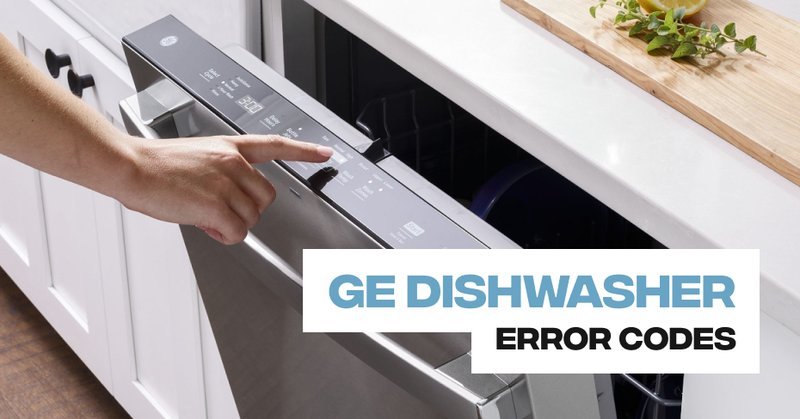
So, you’ve just loaded your dishwasher with dirty dishes, pressed start, and walked away thinking all will be sparkling clean in no time. But, when you return, you’re greeted by an error code—E2—flashing on the screen. Frustrating, isn’t it? This cryptic message leaves many folks scratching their heads. However, there’s no need to panic. Understanding what this error code means is simpler than you might think.
In essence, the E2 error code on a GE dishwasher indicates an issue with the water draining process. It’s like when you pull the plug from your bathtub, and the water doesn’t go down—something’s blocking it. Before you start thinking about calling a repair technician, know that this is often something you can fix yourself with a bit of investigation and elbow grease. Let’s dive deeper into what might be causing the problem and how you can go about resolving it.
Understanding the E2 Error Code
Here’s the deal: the E2 error code signifies that your GE dishwasher is experiencing trouble with draining the water. Dishwashers, much like any other appliance, follow a series of steps to ensure everything runs smoothly. When an E2 code appears, it’s the machine’s way of waving a little flag to get your attention, indicating that something’s wrong in the drainage sequence.
Imagine the dishwasher as a miniature waterpark with slides and tubes. Water should venture in, clean the dishes, and make a quick exit down the drain. When an E2 code comes into play, those “slides” could be blocked. This blockage might result from leftover food particles, grease, or even a kinked drain hose. As the water struggles to leave the machine, the system detects the hiccup, and the E2 error emerges.
You might be thinking, “What could possibly go wrong with draining?” Well, draining is essential for the next cycle of washing to begin. If your dishwasher doesn’t drain properly, it might not clean the dishes effectively, and you could end up with dinner plates that look like they’ve been used as paint palettes.
Common Causes of the E2 Error Code
Let’s talk about why this error code might pop up. One of the most common causes is a blocked drain. Think about how your bathroom sink can get clogged with hair or soap scum. In dishwashers, it’s usually bits of food and soap residue. Over time, these can build up, forming a stubborn clog that prevents water from escaping.
Another reason could be the drain hose. This is the hose that carries dirty water out of the dishwasher and into your home’s plumbing. If it’s crimped or kinked, it’s like a garden hose that’s bent, preventing water from flowing freely. Sometimes, people accidentally push the dishwasher back too far against the wall, causing the hose to kink.
Additionally, there might be a problem with the dishwasher’s pump. The pump is like the heart of the drainage system, pushing out the water. If it fails or gets clogged with debris, the water can’t be expelled as it should. The good news? Most of these issues can often be resolved with a bit of DIY detective work.
How to Fix the E2 Error Code
Now, onto the part where you roll up your sleeves. First things first, turn off and unplug your dishwasher for safety. Once that’s done, inspect the drain filter. It’s typically located at the bottom of the dishwasher. Remove it and give it a good clean. You’ll likely find bits of food and soap scum clinging to it.
Next, check the drain hose. You’ll need to pull the dishwasher out a bit to get a good look. Ensure it’s not kinked or crimped. If it’s clogged, you can try flushing it with a mixture of baking soda and vinegar, followed by hot water, to clear it out. Think of it as a spa day for your dishwasher, where you’re getting rid of the gunk that’s causing the problem.
If these steps don’t do the trick, there might be an issue with the pump. This part can be a bit tricky, so if you’re not comfortable dealing with it, seeking professional help might be the best route. The pump can sometimes get blocked with debris, or it might need replacing if it’s faulty.
Preventing Future E2 Errors
To keep this pesky E2 error at bay, regular maintenance is key. Imagine your dishwasher as a member of your family—it needs attention and care to function well. Clean the filter regularly to prevent clogs from forming. A good rule of thumb is to give it a check every month or so, depending on your usage.
Also, be mindful of what goes into your dishwasher. Rinsing dishes before loading them can greatly reduce the chance of food particles causing blockages. It might seem like an extra step, but it could save you from future headaches. Additionally, ensure the dishwasher is installed properly and that the drain hose stays in good shape.
Think of these steps as similar to flossing for your dishwasher. It keeps everything running smoothly and helps you avoid those unplanned repair expenses. Regular maintenance will help your dishwasher stay in top-notch condition, ready to tackle even the dirtiest of dish loads without a hitch.